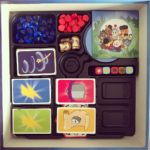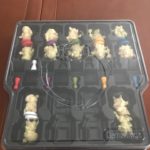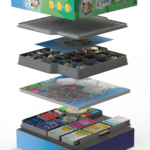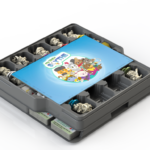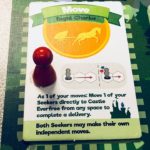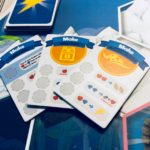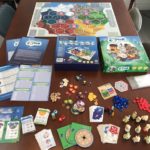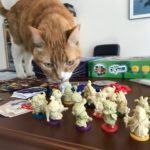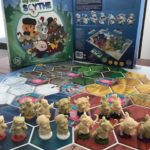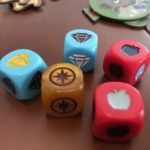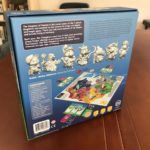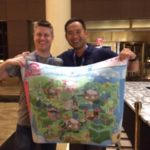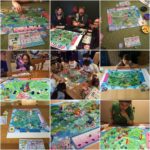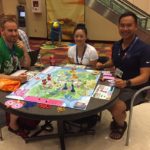This is a compilation of the designer diary entries posted in the My Little Scythe Facebook group. They are listed here in chronological order, with the most recent entry at the top.
***
June 24, 2018: The Custom Insert (Jamey)
In January, I received my Kickstarter copy of The Grimm Forest. Among the many beautiful components in it, I was awestruck by the custom insert. Everything had a specific place, and it made the game easy to set up and clean up.
The company that designed the insert is called Game Trayz, and it’s run by a friend of mine, Noah, whose home-office happens to be about 20 minutes from my home-office. For a while Noah designed and produced custom trays as accessories he sold directly to consumers, but in the last year or so he’s shifted to designing inserts to be produced and included in the game box by the manufacturer.
While I admire Noah’s work and appreciate well-designed inserts in general, I’ve stayed away from them for various reasons. One, they can make it difficult to fit everything into the box (the box is designed and quoted well before the insert can be created), particularly before punchboards are punched. Two, they can add time to the production schedule. Three, they can increase the cost/price of the game. Four, custom trays often require you to plan for expansions that don’t yet exist. And five, while they often look great, sometimes they don’t actually add that much functionality to the game.
But something clicked when I saw the custom trays in The Grimm Forest. I think it helped that it’s a family-friendly game, just like My Little Scythe.
So I reached out to Noah to see if he was interested in working on it. I also started to talk to Panda about the increase in cost and impact on the schedule. At the time, I kept it a secret from Hoby, as I wanted it to either be a pleasant surprise (if it worked out) or a non-factor (if it didn’t work out).
The first version of the tray that Noah proposed was really cool. It included a hexagonal tray containing the minis and tokens for each faction. They each had their own lid, and they sat on top of a bigger tray containing global components. Unfortunately, it costs a lot more to make a lot of little trays than it does to make 1 or 2 big trays, so we couldn’t proceed with that concept.
Noah went back to the drawing board and created a 2-tray, 1-lid concept. I revealed it to Hoby, who was quite excited to learn about it. Panda created a prototype of it, which we used to adjust a few compartments, and then it was time to produce them! We also created a little piece of paper to include in the game to show the order of the components in the box (and to assure people that even though parts of the tray are empty, they’re not missing any components–we left room for expansions.
I hope you enjoy the tray as one of the many elements we provided in the hopes of creating a special My Little Scythe experience for you and your friends, family, and kids.
***
June 21, 2018: Player Count & the Map of Pomme (Hoby Chou)
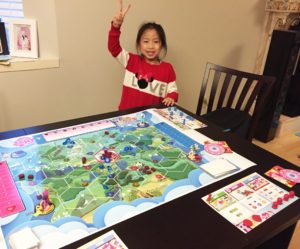 What is in a number? For My Little Scythe, it could mean everything if we’re talking player count. The game’s earliest maps supported 2-4 players. When Jamey Stegmaier asked if it could be adjusted to support the Stonemaier staple of 5-7 players, I said ‘sure’, not really knowing what a chain reaction this would set off in the game’s design.
What is in a number? For My Little Scythe, it could mean everything if we’re talking player count. The game’s earliest maps supported 2-4 players. When Jamey Stegmaier asked if it could be adjusted to support the Stonemaier staple of 5-7 players, I said ‘sure’, not really knowing what a chain reaction this would set off in the game’s design.
Before My Little Scythe became its own distinct game, the premise of the original map was not too far from Scythe’s. There were natural barriers, fixed quest (encounter) spaces, and fixed starting locations for up to 5 players. For good measure, I even threw in cities! But for all the reasons I explained in my previous posts, it was all just too much for the type of game it would become. We lowered the player count to 4 players for both symmetry and faster gameplay, got rid of natural barriers, the cities, and fixed quest locations. This successfully resulted in the fast gameplay that we were after.
Then, Jamey asked about increasing the player count. After I had said yes, I soon realized that I had a small crisis on my hands. I knew that the map at that time would be too cluttered for more than 4 players and needed to be expanded. But after increasing the map’s size, movement across the map became an issue. I did not intend My Little Scythe to be a turtling game and tried a number of different ways to aid with movement. Luckily, the reintroduction of Scythe’s tunnels in the form of portals solved this, as did the introduction of new Move action power-ups.
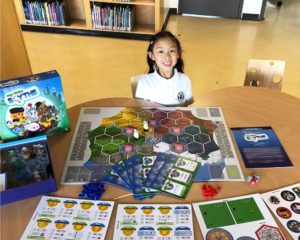 During the map’s evolution, I also got rid of fixed starting locations. Having movable basecamps allowed the game to retain symmetry with variable player counts while also allowing players to sit where ever they want (a big deal for certain players).
During the map’s evolution, I also got rid of fixed starting locations. Having movable basecamps allowed the game to retain symmetry with variable player counts while also allowing players to sit where ever they want (a big deal for certain players).
A bigger board meant that randomly appearing resources created a sprawling mess since gems and apples appeared completely randomly in the print n’ play. Luckily the new Seek mechanic (Jamey’s favourite mechanic) solved this problem as it lets players decide where within a region to place resources. Players are even rewarded for placing them onto opponents’ spaces. This creates a natural curation of gems and apples on the board–their location always purposeful.
Regions were originally numbered, but I advocated for changing these into coloured regions for 2 reasons: it took just a tad too long for players to look for those numbered labels. These labels would also get covered up, hampering gameplay. While we had to say goodbye to the traditional unified map, creating the coloured regions ended up being the right decision as it further streamlined the identification of each region.
The change in player count ultimately remade the game, but in the best possible way! Once it was redesigned, I told Jamey and Katie (our artist) that I’d like the map to be bursting with life. I think they did a great job and I hope you’ll enjoy being immersed in this map too!
***
June 12, 2018: Custom Dice (Jamey Stegmaier)
In today’s design diary, I’m going to talk about friendship, custom dice, and an interesting problem that required a creative solution.
One of the mechanisms that originally attracted me to My Little Scythe was friendship. Specifically, how players gained friendship. Whenever a player selected the Search action, they would roll some combination of dice, and they would place gems and apples in the corresponding regions of the board on territories of their choice. They could place on territories occupied by their minis o empty territories…or they could place tokens on opponents’ territories. For each token placed on an opponent’s territory, you gain 1 friendship.
I LOVE this. It’s such a rewarding choice that feels good for you and the opponent. Sure, you get a friendship, moving you towards a trophy, but an opponent gets a gem or apple. Is it worth it right now? It’s such a fun choice.
However, this fun choice presented a component dilemma. The original prototype dice looked like this (each row contains the 6 sides of a die):
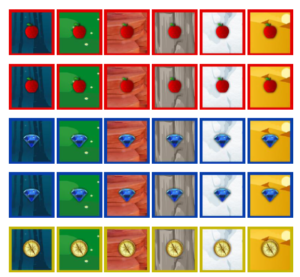
Basically, if you rolled a red die (see the border) with a blue background, you would place an apple somewhere on the board in the blue (swamp) region.
This worked fine as a prototype, but how were we going to make it work for actual custom dice? For a 1:1 translation, we would need to use something like the dice in Star Wars: Destiny, which are fine, but I think custom molded dice have a better feel and table presence. Also, these dice just looked too busy–they’re sending too many signals to your brain (red die, blue background, red apple).
So we decided to flip things around a bit. We made each die monochrome, but we changed the color of the icon on the die to reflect the color of the region. So you roll a red die, and if the resulting apple icon is blue, you’ll place an apple token in the blue region.
This worked well, even though it’s not a perfect solution for people with colorblindness. In fact, the original colors of the icons on the dice were too similar to each other, to the point that in low lighting, the blue and the green looked very similar, as did the grey and the white. I’m happy with the final version, but there may be times where you need to pick up the die to see which color you rolled.
That’s the story of friendship and custom dice in My Little Scythe! Do you prefer custom molded dice like these? Or do you prefer Destiny-style printed dice, or wooden dice with printing?
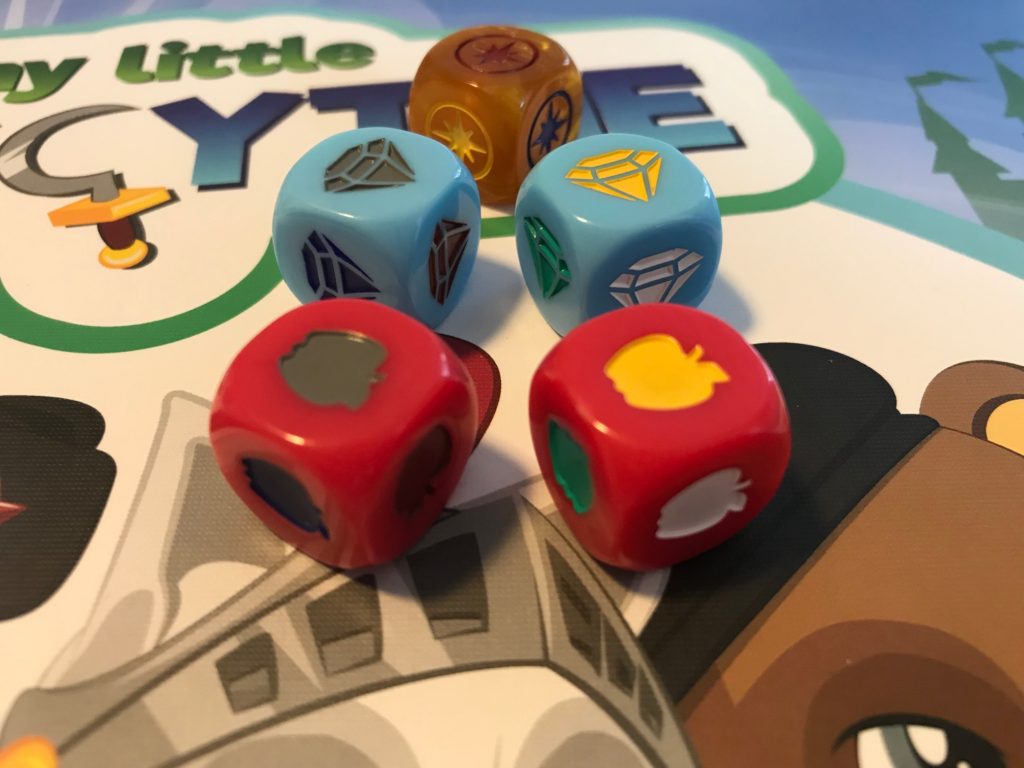
***
June 7, 2018: Power Up Tiles & Engine Building (Hoby Chou)
My Little Scythe’s Power Up tiles permanently upgrade your actions with very powerful benefits. But during the game’s development, we needed to think carefully about whether even this simple engine building mechanic had a place in My Little Scythe.
There are two obvious challenges with engine building games: if players don’t latch onto how engine building works, they often perform poorly (and never recover) against players who have spent time developing their superior engines. There is also a considerable amount of ramp-up time required, something not ideal for players with an action bias. Despite this, we recognized great reasons to pursue this core tenant of Scythe but also wanted to avoid its pitfalls at all costs. The solution we came up with were the Power Up tiles.
In addition to making the game more exciting, Power Ups help add asymmetry and replayability without requiring loads of additional rules or memorization. They contain just the right hint of Scythe’s factory cards, upgrade actions, and engine building into two decks of tiles. In the game, players pay a cost, look through the first 3 tiles of the respective Power Up deck, and choose one to permanently overlay onto their player boards.
Engine building elements were originally designed into the very first My Little Scythe prototype but were shelved in our attempt to simplify the game. Having more vanilla rules unintentionally allowed us to really focus on advancing the core game. We actually got to the point where the core game was fun enough to play without any asymmetry whatsoever. In fact, this was the version that Jamey Stegmaier and Alan Stone ended up signing. The story could have ended here, but I’m glad it didn’t…
Shortly after signing the game, Jamey reached out to me and asked if something can be done to return an element of engine building into the game. Not only was this a core part of Scythe, the resulting replayability is a defining quality of all Stonemaier games. I couldn’t agree more! But in My Little Scythe, we knew that elegance was crucial. Any new rules and abilities should be minimal, intuitive, and never require memorization. We immediately decided to forego Scythe’s various upgrade mechanics and instead go with easy to handle overlay tiles.
Jamey and I worked entirely off of a Google Doc to brainstorm new upgrade abilities for the Move, Seek, and Make actions. In the beginning, we went for a high volume of ideas. Balance, enjoyability, and complexity would be confirmed through testing. And testing we did, first internally and then through blind playtests. We kept only the coolest, most powerful upgrades and then chipped away at balance issues. And because this was a relatively new mechanic, we tested again! A playtester even noted that ‘upgrades’ sounded a bit too technical—and so we renamed these to ‘Power Ups’.
Prompted by Jamey, the Power Up tiles reintroduced a core tenant of Scythe and the original MLS prototype back into the game. While I had originally removed them to avoid the complexities of engine building, having one of the best designers involved reinvigorated the idea in a big way. ![]() ☺ Thanks to Jamey’s commitment, Power Ups became one of the coolest aspects of the game that require zero memorization to use.
☺ Thanks to Jamey’s commitment, Power Ups became one of the coolest aspects of the game that require zero memorization to use.
I’m eager to hear about which Power Up combinations helped you kick pie in My Little Scythe.
***
June 5, 2018: Tom Vasel Eats a Shoe
***
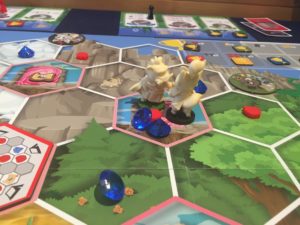 May 28, 2018 (Hoby Chou): Special Delivery!
May 28, 2018 (Hoby Chou): Special Delivery!
Deliveries: originally designed as a means to solve some design problems, deliveries evolved into a defining pick up & deliver mechanic that helps set My Little Scythe apart from its parent game Scythe.
In early prototypes, I needed a solution for two problems. First, players could not seem to spend resources fast enough as gems & apples piled up all over the map. I also intended My Little Scythe’s movement to be far more fluid and dynamic, resulting in a more interactive experience.
I decided to try something not found in Scythe—giving players the ability to deliver set numbers of resources to a certain location. Players with at least 4 apples or 4 gems could deliver them to the centre space (now Castle Everfree) for a trophy. When we tried this, it was an instant hit as players felt great scoring something similar to a “touchdown”. It also solved the two previous problems by reducing resources on the board while giving players an incentive to move around. This was a departure from Scythe, where players might only move resources to avoid the prying eyes of opponents.
Delivery destinations changed after successive rounds of playtesting. Originally players could either deliver to Castle Everfree or to their respective starting base camps. I removed the latter because I wanted to encourage more player interaction. But Jamey immediately noticed a problem with all deliveries going to the centre space. After making a delivery, a player immediately occupied this point of contention whether they want to or not. It was also too easy for any player to squat there and deter all deliveries from other players. This created a game too focused around controlling the centre of the map. I remained committed to creating a game that was interactive, but not necessarily full of conflict. What to do?
My big ‘aha’ moment came when I was thinking of a simple way to create more utility for the 6 portals on the map. Previously portals were used only for quick movement (as with tunnels in Scythe). I experimented with making the centre Castle Everfree space an inbound-only portal for the sole purpose of accepting deliveries. Players could walk their deliveries directly into Castle Everfree, they can take a portal, or a combination of both. This created a whole new world of interactive tactical excitement that did not require fighting over a single space.
But what about turtling the centre of the map? Jamey made a bold suggestion—let’s remove the ability to occupy the centre space altogether (how un-Scythe-like of him right?). Playtesting showed that central crowding was a point of frustration for many My Little Scythe players. We knew we needed a different and more pleasant system.
Here’s how it now works: With regular movement, players are no longer able to walk right into the centre space unless it is to complete a delivery. After a delivery, players are immediately teleported back to their base camps and provided a small bonus. This means if others are keen to defend against an upcoming delivery, they will be required to come up with more tactical and creative means to do so. Conflict is still possible, but it is not forced.
As I reflect back, the evolution of deliveries represents a process of patiently working with Jamey and playtesters to create an uncompromisingly fun solution that was also elegant. Net changes since the original prototype resulted in no more than 2 extra lines of rules, but required months of development. Was it worth it? In my mind, absolutely! And I hope you will think so too!
***
May 25, 2018 (Jamey Stegmaier)
In today’s design diary post for My Little Scythe, I’m going to talk about the components.
I really liked the aesthetic of the original PnP: playful, cheery, bright, and cartoony. So after some discussions with Hoby, we decided to pursue that same aesthetic for the game.
I know artist Katie Khau from the annual Stonemaier Games Design Day, and her art style seemed like the perfect fit. Katie was open to the project, and I had a lot of fun seeing her creations appear in my inbox over the next 6 months or so (especially the various Easter eggs she sneaked into the board and cards).
Another major contributor was Heriberto Martinez at Marchen Atelier, an amazingly talented 3D modeler. Heriberto can work in a bunch of different styles (he’s created miniatures for Scythe, like the airships), but I think he really excels in the chibi style of the My Little Scythe miniatures.
By the way, you might notice that My Little Scythe plays up to 6 players, but there are 7 pairs of Seeker miniatures. Hoby created a board that is perfectly balanced for up to 6 players, but not 7, yet we didn’t want to leave out any of the animals from Scythe. So we included them all–that way, even the last player to pick their Seekers still has a choice.
Finally, I need to mention Christine Santana, our graphic designer, and Hoby Chou himself. Hoby proved to not only have an acute eye for visual design, but also quite excellent Photoshop skills. I had to adjust my approach a bit as a project manager to allow Hoby’s talents to have a consistent direct impact on the art, and I think the end result is worth it.
My target price for My Little Scythe was $50, and while we pushed that budget to the seams, we also had to make some tough choices along the way. For example, it quickly became clear that wooden (or even plastic) tokens for the friendship, pie, and trophy tokens weren’t feasible. Likewise, even though Heriberto had created full-color 3D files for the miniatures, offering pre-painted minis would have ballooned the cost of each game up to $80, which just doesn’t work for a family-friendly game. (We did, however, use those images for the painting guide.)
But I think the end result still feels like a premium game at a reasonable price–at least, that’s what I aim for when I construct and price our games. You can be the judge of that when you get your copy. :)
I’ll talk about the custom tray from Game Trayz and the custom dice in my next post.
***
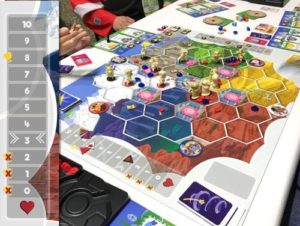 May 22, 2018 (Hoby Chou): Friendship is “Magic”
May 22, 2018 (Hoby Chou): Friendship is “Magic”
Like most of the mechanics retained from Scythe, Friendship (Popularity in Scythe) was re-engineered to fit the direction My Little Scythe was taking. I’d like to share how Friendship differs from Popularity and how it evolved this way.
Friendship was originally just a thematic change from Popularity meant to fit the original PnP’s My Little Pony theme. Like Scythe, the very first prototype used Friendship as a tiered multiplier to score final points. But as My Little Scythe evolved away from Scythe’s win conditions, this method of scoring became less relevant. More importantly, we heard from our playtesters that My Little Scythe needed a more streamlined and more enjoyable way to track progress.
When My Little Scythe began using trophies to track game progress, Friendship was left without much utility or relevance except for the singular purpose of scoring the Friendship trophy. For a little while we were out of ideas and even considered removing it. But I’m glad we didn’t as it would later evolve to become one of the most important characteristics of the new game.
The answer to our Friendship problem came as soon as Vienna and I dreamed up the new storyline behind My Little Scythe. Being a friendly tournament, the importance of sportsmanship was a natural consideration. Some player choices add Friendship while others reduce it.
Eventually Friendship took on 2 new roles: trophies recognition and tie breaking.
In addition to being a scoring condition (8 Friendship nets you a trophy) Friendship level became a precondition for earning any trophies at all. When a player dips below 3 Friendship, tournament judges will no longer recognize that player’s trophies until their Friendship is restored to a minimum level.
Friendship also has one final important role—tournament tiebreaker. Having ties can be common in My Little Scythe so it was important that we found a meaningful tiebreaker. Thematically it made the best sense to have Friendship be that tiebreaker for being a “good sport”. But mechanically, having high Friendship reflects a tendency for helping others. We found the idea of winning despite deliberately helping others to be challenging yet incredibly rewarding.
What do you think of how Popularity evolved in My Little Scythe?
***
May 15, 2018 (Jamey Stegmaier)

***
May 11, 2018 (Hoby Chou)
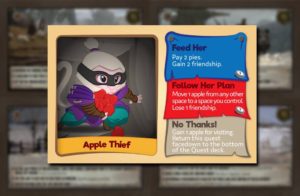 Like the Encounter cards of Scythe, Quest cards are also immediately revealed by the player who lands on a Quest token. However, Quests work differently. While Scythe Encounters contain 4 options that affect the current player, Quests are more interactive and contain a pattern of 3 unique choices:
Like the Encounter cards of Scythe, Quest cards are also immediately revealed by the player who lands on a Quest token. However, Quests work differently. While Scythe Encounters contain 4 options that affect the current player, Quests are more interactive and contain a pattern of 3 unique choices:
There’s always a “blue” option that provides an immediate benefit to the player at a cost. This most resembles Scythe Encounters since it only affects the player discovering the Quest.
The remaining two options are a departure from Scythe.
The middle “red” option typically affects other players (but not always) and typically involves sacrificing Friendship. Sometimes it could be as simple as transferring an apple from a far-away space. It seems subtle, but what if that means delaying a player from scoring a delivery (a new mechanic in My Little Scythe) or crafting something critical?
The final “beige” option is always NO THANKS. While in Scythe you are required to immediately resolve Encounters, in My Little Scythe you can choose to gain a small free benefit and return the card into circulation instead. Returning the card into circulation means others may come across it later and reap its benefits.
My Little Scythe isn’t a re-skin but a deliberate re-engineering of an already fantastic game. Mechanics from Scythe were reviewed one by one and revised, removed, or replaced to create a unique experience in My Little Scythe. Quests are an example of something that has been revised.
***
May 8, 2018 (Jamey Stegmaier)
Hoby will be writing some design diary posts for this group (the first one was on Sunday), and I’m going to add some from my perspective as a publisher, developer, and fan of the game. Today I’ll talk about how we came to sign My Little Scythe as a Stonemaier product.
It’s no secret that the original print-and-play version of My Little Scythe had a My Little Pony theme. So originally, after I noticed how much attention it was getting over a sustained period of time, I thought the only way it could be published was if we partnered with Hasbro.
I have a contact at Hasbro, so I reached out to them to see if they were interested in making My Little Scythe or if they would be open to us licensing the My Little Pony IP specifically for the game. The answer to both questions was “no.” They were polite but firm about it.
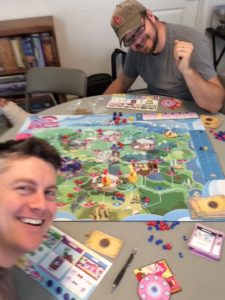 I don’t remember exactly who or when we realized that we didn’t need the pony theme—we already had a bevy of animals in Scythe that we could “cutify” for the game…if the game was actually good. So flash forward a few months later, and Hoby and I Hoby offered to show the game to me at Gen Con. While we didn’t have the chance to play it, he graciously gave me a very nice prototype to take home.
I don’t remember exactly who or when we realized that we didn’t need the pony theme—we already had a bevy of animals in Scythe that we could “cutify” for the game…if the game was actually good. So flash forward a few months later, and Hoby and I Hoby offered to show the game to me at Gen Con. While we didn’t have the chance to play it, he graciously gave me a very nice prototype to take home.
The photo you see here is my first play of the game with my co-founder, Alan. We were absolutely surprised and delighted by it. Not only was it a lot of fun due to the playful nature of it, but it also had some really compelling, unique mechanisms. I didn’t want to publish a reskinned version of Scythe, and this playtest confirmed that My Little Scythe was very much its own game. I recall Alan and I simply leaning back in our chairs after the playtest, smiling, and saying, “We need to publish this.”
I e-mailed Hoby later that day to let him know that Stonemaier Games very much wanted to publish My Little Scythe.
I look forward to delving deeper into the decisions we made during the development of the game in future design diaries, but I wanted to start with this. If you have any questions, please let me know!
***
May 6, 2018 (Hoby Chou)
This first entry is a prelude. While it doesn’t dive into design or gameplay, I think it covers one of the most important topics–inspiration. Inspiration makes all the difference between accepting who you are today vs. reaching for who you can be tomorrow. It helped me find that extra spark to discover and try fresh things that I’d normally never do in board games. For My Little Scythe, it dared us to create a strategy game that draws gamers of all ages and skill together.
The most obvious inspiration for My Little Scythe was its parent game Scythe. Its engrossing theme and gameplay drove us to feverishly find ways for younger and more casual players to appreciate its beauty. But beyond Scythe, Jamey Stegmaier has alway impressed me as a role model. Before my first interaction with him, I was drawn to his humble character and his community building. Here’s this award winning visionary who’s also passionate about building that personal connection with gamers, something that I highly value as both a customer and designer. I’ll share more about what it’s been like to work with Jamey in future posts.
Many of you know that I also had a very personal inspiration–my daughter and co-designer Vienna. The original prototype was–as many of you rightfully labelled–a labour of love. If you don’t have children, this likely applies to you anyway. Think back to when you wrote that first special letter to someone you had a crush on, or made that first Valentine’s surprise. I bet you could have spent all night turning it into your best work because all you cared about was making that person happy. While sounding cheesy, love really is a powerful source of inspiration.
We never imagined having our homemade game published. But there’s definitely a lesson here: if you do something you love, and for someone you love, people tend to take notice.
What has inspired you to lift yourself beyond your known limits? If you design games, where do you find inspiration?
***
